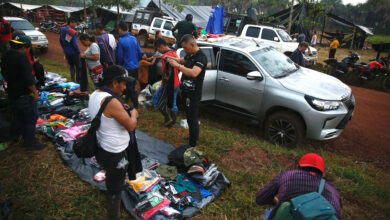Exhibition seeks justice for victims of police violence in Colombia

By Irene Escudero
Bogotá, Jun 2 (EFE).- Nury Rojas stares at a photograph displayed on the wall, sighs and with a lump in her throat says: “Here I am for you.”
She touches a photo of Angie Paola Baquero Rojas, her daughter who was killed during the September 2020 protests in Colombia against police brutality.
A selfie of Angie Paola looking at the camera is one of the portraits in the exhibition “Stolen Lives” by Colombian artist Doris Salcedo at the National Museum of Colombia in Bogotá.
It brings together the faces and stories of people who died during protest, from 2019 to 2021, at a time when police violence in Colombia is more topical than ever, after the 60 deaths in demonstrations in the past month, according to social organizations.
Some faces are already symbols of the protests, such as that of Dilan Cruz, an 18-year-old who died on Nov. 25, 2019, four days after receiving pellets in his head from a shotgun reportedly fired by a member of the Mobile Anti-Riot Squad (Esmad).
Or that of Javier Ordoñez, a lawyer who allegedly suffered torture in a Bogotá police station on Sep. 8.
Others have become known in recent weeks, such as Lucas Villa, a young man who was shot eight times by unknown persons on May 5 in Pereira.
Many memories are just a name on the wall, a date – 2021 – but they have no photo or age or description of what happened. It is only known that they died in the context of protests.
Most of the portraits are of young people and even minors such as Alison Menéndez, allegedly sexually assaulted by police, and Marcelo Agredo Inchima, allegedly shot by police in Cali on Apr. 28.
Among all these faces, one with wrinkles catches the eye: that of Jovita Osorio, a 73-year-old woman who died of cardiac arrest in Cali on Apr. 30, after tear gas landed at her home.
The exhibition, which will show until June 27, was inaugurated on Tuesday, and on Wednesday received a special visit from some of the mothers and relatives of the victims portrayed on the walls.
“When the death of Javier Ordoñez occurred, citizens came out to protest and demonstrate against police brutality and the police fired shots at protesters. That day there were many injured and 13 dead, including my daughter, Angie Paola, that’s why I’m here (…) so as not to forget what happened last year,” the mother of this young woman, who had turned 30 on Feb. 22, told EFE.
Rojas has embarked on a search for justice, like so many other mothers in Colombia.
With a firm expression, the mother looks at the camera after each interview: “I am Angie Paola’s mother and until the last consequences I will be standing up asking for truth and justice for my daughter and for all the people who are injured, dead, disappeared, and to know who gave the order for these massacres to take place.”
Rojas’ fight coincides with that of María Elena Meneses, who assures that “we will not rest until justice is done” in the death of her son, Christian Andrés Hurtado.
The 27-year-old was hit by a bullet in Soacha, a city neighboring Bogotá, the same day as Angie Paola and three months after he had gone to live with his girlfriend.
The stories of Meneses’ and Rojas’ children have been repeated in recent weeks in the country: reports of police brutality, excessive use of force and firing at protesters.
“They keep massacring, they keep killing, attacking, making (the protesters) disappear, crippling them … and they are only kids,” says Rojas.
“The kids have opened their eyes and now they have to close them. Why? They have the right to think, they have the right to ask for a change in this country, so why are they being silent?” EFE





